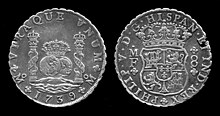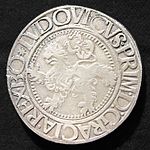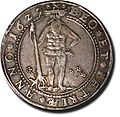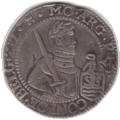Thaler

A thaler or taler (
While the first standard coin of the
The thaler silver coin type continued to be minted until the 20th century in the form of the
Etymology
German taler is recorded from the 1530s, as an abbreviation of Joachimstaler. The silver mines at Joachimstal had opened in 1516, and the first such coins were minted there in 1518. The original spelling was taler (so Alberus 1540). German -taler means "of the valley" (cf. Neanderthaler). By the late 16th century, the word was variously spelled as German taler, toler, thaler, thaller; Low German daler, dahler. In 18th to 19th-century German orthography, Thaler became standard, changed to Taler in the 1902 spelling reform.
The name taler, thaler was soon used in compounds denoting various types of silver coins of thaler size, thus
Units used in the Netherlands include the daalder, the rijksdaalder and the leeuwendaalder. From 1754, many German states used the Conventionsthaler as well as a lower-valued North German thaler or Reichsthaler worth 3⁄4 the Conventionsthaler. From 1840 the various North German thalers converged to the value of the Prussian thaler and afterwards the Vereinsthaler.
The corresponding English silver coin of the period was the crown. The Low German word was adopted in English as daler by 1550, modified to dollar by about 1600.[1] English thaler was introduced in the first half of the 19th century to refer to the coins of the German states, as the word dollar was increasingly understood to refer to the United States dollar.
Predecessors

The development of large silver coins is an innovation of the beginning
Even these coins were increasingly debased due to the Great Bullion Famine of the 15th century which occurred for several reasons including continued warfare and the centuries-long loss of silver and gold in indirect one-sided trades importing spices, porcelain, silk and other fine cloths and exotic goods from India, Indonesia and the Far East. This continual debasement had reached a point that silver content in Groschen-type coins had dropped, in some cases, to less than five percent, making the coins of much less individual value than they had in the beginning.
This trend was inverted with the discovery of new and substantial silver deposits in Europe beginning in about the 1470s. Italy began the first tentative steps toward a large silver coinage with the introduction in 1472 of the
Finally, with the silver deposits—being mined at Schwaz—to work with and his mint at Hall, Sigismund issued, in 1486, large numbers of the first true thaler-sized coin, the Guldengroschen ("gold-groat", being of silver but equal in value to a Goldgulden). It was an instant and unqualified success. Soon it was being copied widely by many states who had the necessary silver. The engravers, no less affected by the Renaissance than were other artists, began creating intricate and elaborate designs featuring the heraldic arms and standards of the minting state as well as brutally realistic, sometimes unflattering, depictions of the ruler (monarch).
Joachimsthaler
By 1518, guldiners of similar weight to guldengroschen were popping up everywhere in central Europe. In the
Similar coins began to be minted in neighbouring valleys rich in silver deposits, each named after the particular 'thal' or valley from which the silver was extracted. There were soon so many of them that these silver coins began to be known more widely as 'thaler' in German and 'tolar' in Czech.
In the 17th century, some Joachimsthalers were in circulation in the Tsardom of Russia, where they were called yefimok (ефимок) – a distortion of the name Joachim.
Holy Roman Empire
The new large silver coins that became ubiquitous as the 16th century went on were named Thaler in German, while in England and France, they were named crown and écu, respectively, both names taken from what had originally been
The first large silver coin standardized by the
See the chronology of thaler development for the development of the Reichsthaler and related currency units from 1566 to 1875. Confusingly, there also was defined a North German thaler currency (also called Reichsthalers) of less value to the standard Reichsthaler specie coin; this thaler was worth 12 to a Mark after 1690, 131⁄3 to a Mark after 1754, and 14 to a Mark (the Prussian thaler) by the 1840s. Furthermore, in 1754 a Conventionsthaler was developed by the Austrian Empire minted at 10 to a Mark of fine silver. While it was adopted by most German states, Scandinavia and a few North German states retained the original Reichsthaler specie of 91⁄4 to a Mark as their standard coin until 1875.
-
17th-century thaler coin fromwoodwose design on coins from the mints in the Harzmountains.
City view thalers and lösers

The "city view" thalers of the 17th and 18th century have predecessors in stylised representations of cities (as three towers, or a city gate) on the obverse of thaler coins in the late 16th century, such as the
In the late 16th and 17th centuries, there was a fashion of oversized thaler coins, the so-called "multiple thalers", often called
Dutch Republic
-
leeuwendaalder or lion thaler, 1660
-
Dutch rijksdaalder, 1622
-
Maria Theresa Kronenthaler, 1770, showing the Burgundian Cross with 4 crowns
The
minted armored half bust rijksdaalders until the end of the 17th century.The pace of depreciation of the small-denomination
The bank's success helped the Dutch Republic become Europe's financial center in the 17th century and maintain the reichsthaler as its banking currency unit despite Germany's descent into the chaos of the Thirty Years' War. As a bullion entrepôt of the period, the Netherlands produced reichsthalers for Germany and Scandinavia, and exported leeuwendaalders to the Levant and the Ottoman Empire. The latter survives to this day in the form of the Bulgarian lev, Romanian leu, and Moldovan leu. [4][5][6]
Lion Daalders were used a lot in Europe, Africa, the Middle East and in what's now known as the USA. The city of New Amsterdam, currently New York, was founded by the Dutch in the early 17th century. "The Lion Daalder holds an important place in American history as America’s first dollar and the root of the word from where the current currency, the US Dollar, found its name."[1]
By the 18th century the Spanish-controlled Dutch territories eventually became the Austrian Netherlands. In 1754 it issued the Kronenthaler of weight 29.45 g and 0.873 fineness, or 25.71 g fine silver. This coin was adopted by many South German states by the early 19th century.
The term daalder continued to refer to 11⁄2 gulden in currency even after the discontinuation of the 11⁄2 gulden or 30 stuiver piece in the 19th century.
The rijksdaalder was also known as the silver ducat, which is still minted for collectors in the Netherlands today.
Spain and France


The discovery of massive silver supplies in
The rise of German and Spanish dollars in 16th century European trade lessened the demand for French silver francs and testoons. In 1641 King Louis XIII therefore introduced a new Louis d'Argent equal to the Spanish dollar and worth three livres tournois, weighing 27.19 g and 0.917 fine. In 1726 France issued its own thaler coin, the silver écu of 6 livres with about 26.7 g fine silver; it would also find currency in Southern Germany and Switzerland as the laubthaler. Finally, in 1795 the French franc was established, with the 5-franc coin of 25.0 g, 90% fine silver being closest in size to the thalers used elsewhere. The French franc system would be expanded to other countries in the advent of the Latin Monetary Union of 1865.
Switzerland


The
The
By the 18th century,
Eventual transition to this first new Swiss franc stalled in the 19th century while public preference shifted to the South German Kronenthaler of 25.71 g fine silver, valued at 3.9 francs or 39 batzen. In 1850 Switzerland established the modern-day Swiss franc at par with the French franc, with 40 Swiss francs exchanged for 7 kronenthaler. The five-franc coin of 25.0 g, 90% fine silver became the coin with the closest value to the different historical thalers.
The name thaler was introduced to Scandinavia as daler. The first Swedish daler coins were minted in 1534. The Norwegian speciedaler was minted from 1560. Later Scandinavian daler coins included the
These currencies in Denmark and Sweden were replaced by the Danish krone and Swedish krona in 1873, the new currencies introduced by the Scandinavian Monetary Union. Norway joined the Monetary Union and introduced the Norwegian krone in 1876.
19th-century Germany

At the beginning of the 19th century the South German states valued the Conventionsthaler at 2.4 South German gulden, or 9.744 grams fine silver per gulden. Afterwards, however, they began to mint the Kronenthaler valued at 2.7 gulden - hence a reduced fine silver content for the gulden at 9.52 g. In 1837, the Prussian thaler was fixed at 13⁄4 South German gulden - hence 9.545 g fine silver per gulden.
The
Within the new German Empire, silver vereinsthaler coins remained unlimited legal tender at a value of 3
The
Legacy
Though various silver thaler coins were minted in most of Europe until the 1870s, these coins were more often counted in non-thaler currency units like Dutch or Austrian guilders, French francs, Spanish reales, etc. By the mid-19th century the thaler (or reichsthaler, rigsdaler) was still the currency unit used in the North German Confederation and Scandinavia. By 1875 the thaler itself disappeared as currency unit in Europe upon adoption of the gold standard.
Nonetheless, use of the thaler as currency continued outside Europe in the form of the
Thaler-sized coins minted to late-19th century standards would be minted until 1914 in Mexico and in most of Europe, until 1928 in Switzerland, and until 1934 in the United States. Henceforth thaler-sized silver coins would be minted as bullion or numismatic pieces, among them:
- The Maria Theresa thaler trade coin
- Modern silver commemorative Talers minted in German-speaking Europe; e.g. the Swiss Schützentaler, the Swiss Helvetia-Taler, and the Austrian Haller-Taler.
- The American Silver Eagle, which at 1 troy ounce (31 g) fine silver is actually heavier than the original silver dollar.
Unrelated to specific coins, the name of the thaler survives in various modern currency names, in the form dollar in twenty-three currencies used in countries including Australia, Canada, Hong Kong, New Zealand and the United States of America, and also in the Samoan tālā and the Slovenian tolar (before adoption of the euro).
Chronology of thaler development

- 1486: Sigismund of Tirol issues his 31.93 g Guldengroschen of 60 Kreuzersand .9375 fineness.
- 1493: Switzerland issues its first Guldengroschen at Bern
- 1499: Hungary issues the first Guldiner/Guldengroschen. It is the earliest year of issue with Arabic numerals on the coins in Hungary.
- 1500: The first German Cologne Mark.
- 1518: The first coin actually called a "Thaler" is minted in Joachimsthal, Bohemia, Holy Roman Empire, also weighing 29.232 g.
- 1524: The money ordinance
- 1534: Saxony and Bohemia alter the fineness of their guldiners (or 1-guilder coin) down from .9375 purity to .903 while maintaining the same coin weight, thus lowering the actual amount of pure silver in the coin. This made the imperial Guldengroschen worth more than the locally issued guldiner.
- 1551: A new money ordinance is decreed in Augsburg that lowered the guldengroschen's fineness to 0.882 but raised its weight to 31.18 g. Many German states begin to accept this standard guldengroschen, but valued higher at 24 groschen or 72 kreuzer, further reinforcing its separation from the accounting gulden defined as only 60 kreuzer. A huge variety of other accounting subdivisions of the coin prevailed throughout the Empire.
- 1559: After the death of the Holy Roman Emperor Charles V, yet another money ordinance is decreed at Augsburg, which discontinued the 72-kreuzer guldengroschen (minted at 8.533 to a Cologne Mark of fine silver) in favor of a 60-kreuzer "guldiner" or 1-gulden coin minted at 10.24 to a Mark.
- 1566: Protestations over the disappearance of the guldengroschen resulted in the issuance of the Cologne Markof fine silver). While modestly lighter than the guldengroschen, its public acceptance at the same price of 24 groschen or 72 kreuzer (or 10.8 guilders to a Mark) doomed the now-underpriced guldiner.
- 1618: The Reichsthaler was valued at 24 groschen, or 90 kreuzer, or 11⁄2 gulden on the eve of the Thirty Years' War of 1618–1648 and the Kipper und Wipper financial crisis which destroyed Germany's various monetary systems.
- 1667: An Brunswick-Lüneburgto help make the minting of small coins more economical than could be done under the old Augsburg ordinances led to the creation of a lower-valued Thaler, still worth 11⁄2 gulden or 90 kreuzer, but equal to 6⁄7 of the original Speciethaler (or 101⁄2 Zinnaische thalers to a Cologne Mark of fine silver). Northern European states like Denmark, Hamburg and Lübeck acceded to this convention.
- 1690: The Leipzig Money Convention met to deal with the poor quality of coinage in Saxony, Brandenburg, and Brunswick, as well as the limited acceptance of the 1667 Zinnaische standard. The agreement reached was to reduce the gutegroschen, 36 mariengroschen, etc.
- 1750: This year saw yet another reduction in weight in the areas controlled by Brunswick-Wolfenbüttel down to just 22.272 g and a .750 fineness. 14 Prussian thalerswere minted from a Cologne mark of fine silver.
- 1754: The monetary agreement between Austria and Bavaria in 1753 replaced the original Speciethaler by a new Austro-Hungarian florins, or 2.4 South German gulden. Over time this coin would spread into a large portion of central and southern Germany but not in Scandinavia.
- From 1820: The Kronenthaler (a thaler with 3 or 4 crowns between the Burgundy cross), a coin first issued in 1754 by the Austrian Empire for use in the Austrian Netherlands (present-day Belgium), became widely adopted by various Southern German that the rate of to 2.7 South German gulden. The kronenthaler had a weight of 29.45 g and a fineness of .873.
- From 1837: the Prussia-led Zollverein customs union led to a more vigorous transition into the Prussian currency standard, with North German thalers being replaced by lower-valued Prussian thalers worth 14 to a Cologne Mark of fine silver (or 16.704 g), and with each thaler now divided into 30 silbergroschen. The Prussian thaler was also fixed at 13⁄4 South German gulden.
- 1857: The Vienna monetary contract finally eliminates the Cologne Mark as a standard against which the silver coinage of Austria and Germany are reckoned, replacing it with a simple tariff of 500 g fine silver. 30 Austro-Hungarian florins, 13⁄4 South German gulden, 30 silbergroschen, and other subdivisions.
- 1873: The gold marksdespite its bullion value dropping below 3 gold marks over the next several years.
- 1908: The Vereinsthaler was officially demonetised in Germany and made worth only bullion value.
See also
- Ausbeutetaler
References
- ^ Christian Ludwig, Teutsch-Englisches Lexicon (1789), c.448 gives dollar, doller as the English translation of Thaler.
- ^ Year: 1620–1621; Composition: Silver; Weight: 28,4 gram; Diameter: 42 mm - https://en.numista.com/catalogue/pieces94533.html
- ^ Gold medallic portugalöser (10 ducats)
- ^ "Online Etymology Dictionary". www.etymonline.com.
- ^ "Production of the Leeuwendaalder". www.coins.nd.edu.
- ^ "Lion Dollar – Introduction". www.coins.nd.edu.
- ^ Künker Auktion 316, Numismatischer Verlag Künker (2019), 282.
- ^ MAIN reference: German monetary system. p. 360–393.
Books
- Duve, Gebhard (1966). HISTORY OF THE REDEEMABLE, MULTIPLE AND MINING TALERS OF BRUNSWICK-LUNEBERG. Johannseburg: Duve.
External links
 Media related to Thaler at Wikimedia Commons
Media related to Thaler at Wikimedia Commons



![thaler of the County of Tyrol, Leopold V - 1621.[2]](http://upload.wikimedia.org/wikipedia/commons/thumb/a/af/1_thaler_Leopold_V_of_Austria_-_1621.png/120px-1_thaler_Leopold_V_of_Austria_-_1621.png)






